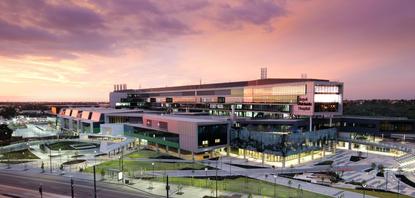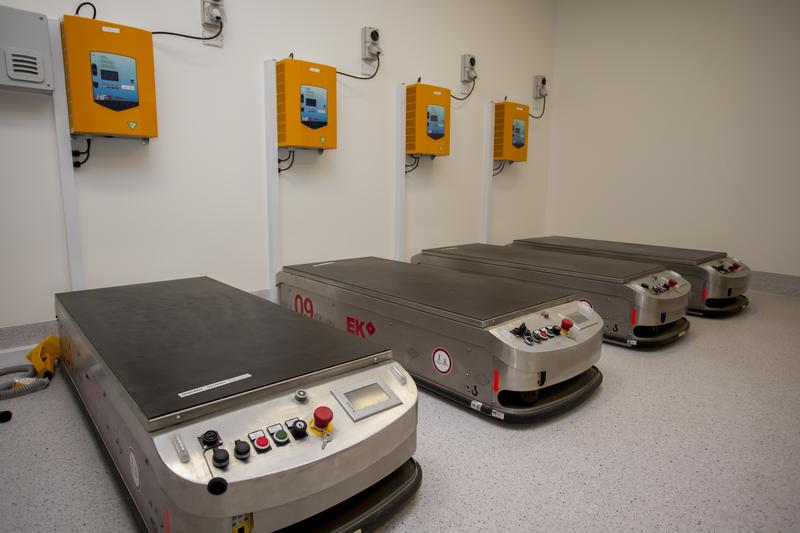Futuristic ‘tech savvy’ Royal Adelaide Hospital set to open doors
- 24 August, 2017 14:31

From stainless steel high-tech robots that can talk to lifts, doors and portable phones and carry goods around the hospital to a pneumatic tube system that transports specimens to 74 stations, the new Royal Adelaide Hospital is promising to be a genuine ‘high tech hospital of the future.’
For starters, the hospital is implementing the use of electronic tags keeping track of equipment and patients, a digital instrument tracking system, wireless patient nurse call system, electronic bedside devices, distributed medical imaging; and self-service electronic kiosks.
And those are just some of the technology innovations on display at the hospital, which is set to open its doors on September 5, according to SA Health executive director eHealth and CIO Bill Le Blanc, who has helped steer the IT ship on this colossal multi-pronged project.
The hospital, considered to be the most technologically advanced hospital across the country, can now also be considered Australia’s “most advanced digital hospital,” Le Blanc told CIO Australia.
“This is the biggest investment that the state government has made in its history. It is extremely significant,” Le Blanc said. “It is positioning us to provide healthcare to the community for the next 30 years. It is absolutely a step change. There is no comparison between the old hospital and the new hospital - and in fact there’s no comparison between this new hospital and any other hospital in Australia."
The pneumatic tube system, for example, is one technology advancement taking things to a whole new level.
“There are depots throughout the hospital where staff can insert a tube into the system, program where it needs to go to, and the system will then suck it in and deliver it from there. At the other end, the tube gets dropped into kind of like a vending machine, where the tube drops out the bottom with its specimen into a little tray,” said Le Blanc.
The rise of robots
Certainly, the hospital is “loaded with amazing IT innovations,” said Le Blanc, explaining the automated guided vehicles (AGV) - the stainless steel robotic devices that can carry large trolleys with goods at average walking pace and can talk to lifts, specific doors and portable phones - are particularly exciting.

“These are the driverless robots. There are 25 of them that will ferry 1,600 trolleys around everyday, carrying food, linen, surgical instruments and then they work behind the scenes. They travel in dedicated lifts, dedicated corridors, dedicated lift lobbies. There are some areas where the public and staff may come into contact with them, but they have sensors and they will stop moving if they come across a human," Le Blanc said.
“This is our first foray into robotics. We’ve gone from no robotics to lots of robotics in this hospital, which is exciting,” he said, explaining the pharmacy dispensing robots are another example of innovation at work."
Both hospital pharmacies - the inpatient and outpatient one - have a robot each, which help ensure better tracking of pharmacy items and reduces wastage.
“It is like a robotic stock picker like you might see in a warehouse at Amazon. In this case it is picking medication. That is exciting because it allows a higher throughput for the pharmacy. This technology is not just significantly decreases errors (up to 65 per cent reduction in dispensing errors, as measured overseas), but it also allows us to do better stock control."
He said once the pharmaceuticals reach the ward, they are put into computerised dispensing cabinets, called automated dispensing cabinets, which make access to medication easier, faster and safer.
“There are over 100 of them spread throughout the hospital. In an old hospital, you’d have a stockroom where the nurses will go in and pick the medication based on what the patient has been prescribed. Everyone sets out to do their best, but there is scope for human error in that process."
The dispensing cabinets at the ward level are biometrically secured, which means nurses need to put in their identification and fingerprint to access the cabinet.
“And when they do so, the nurse puts in which patient they are retrieving medication for, and the cabinet only pops out the drawer that contains the right medication and the right dosage for that patient. It further reduces picking errors, and further reduces the stock against theft or any inappropriate access."
IT innovation at work
Another major breakthrough, Le Blanc said, comes in the area of the hospital’s 40 operating theatres, where new high-tech equipment in the rooms will give surgeons a data-rich environment thanks to the ‘clinical data integration’ approach.
“There are giant swing arms that come down from the ceiling. They will have up to four to six computer monitors, which allow simultaneous data feeds from either medical scopes, electronic medical records, biomedical metrics in real-time from the operation. Images such as x-rays, CT scans, MRI," he said.
"They are no longer displayed on a light board on the wall - these are now on computer monitors that are hanging up on either side of the patient's bed that provides a very data rich environment for the surgeons to help them with their processes and decision-making.”
Additionally, he said all operating theatres and treatment rooms have a plethora of high definition video cameras in order to capture all procedures in high definition video.
Meanwhile, another advancement comes on the wireless front as the hospital is now using a wireless location system.
“There are over 3,200 wireless access points, wireless antennas in the hospital, and that saturation gives us the ability to triangulate the location of assets that we might need such as wheelchairs or infusion pumps. And it allows us to save time around a more efficient operation."
The system is also integrated with a staff alarm system. “There is a need for security services in modern hospital environments where staff need assistance. In your historical hospital, there will be a red button on the wall or under the reception desk that will alert that security is required. With this wireless mobile duress system, staff carry a wireless device that can activate an alarm, which tells security people exactly where they are in real-time so they can send people to the specific area,” he said.
The hospital has also launched the largest automated microbiology laboratory testing system in the Southern Hemisphere, dubbed the BD Kiestra Total Lab Automation, which will help treat infectious diseases. It will help automate the process of specimens including blood, urine and wound swabs, said Le Blanc.
Asked what underpins some of the tech advancements, Le Blanc said it involves a robust hardware infrastructure.
“The hospital needs to be highly resilient and work in island mode. Most of our big backend IT systems are run in a dual datacentre environment. But should the hospital be cut off through a natural disaster, for example, the hospital needs to be able to run on its own generation, if it is cut off from its electricity network or its own datacentres. It has a very highly resilient fibre network capability. There is a lot of resilience in the wireless network as well,” he said.
And in addition to high-tech robots, and big bold infrastructure behind the scenes, he said another important aspect of advancement to consider is the administrative and recordkeeping functionality, which will provide data to the clinicians and enable their decision-making.
“Some of the less sexy stuff around electronic medical records is absolutely key to making this hospital function. And we believe we are bleeding edge there in terms of not just the breadth, but the depth to which we use our electronic medical records system in comparison to our peers,” said Le Blanc.
Lessons learned
Le Blanc said the project which started 10 years ago, has taken the last three years to implement the ‘forward thinking’ technology.
“Planning started about ten years ago. The technology environment started in earnest about five years ago and it has been a good full three years in implementation."
The biggest challenge on the technology side was finding a balance.
“We can’t do it all on our own. There is so much new technology in this space that you have to get assistance, advice and guidance from others, right from around the world. But also at the same time, you want to position yourself to be self-sufficient when the project is complete."
But more than technology angst, he said the bigger challenge has been organisational and cultural change “and taking the staff of a hospital on a journey of change.”
“This is not just about technology. The whole way in which this hospital works is a dramatic departure from the way that clinical services that previously been delivered, he said, citing new advancements in the radiology space including the use of mobile radiology units," he said.
“In the new hospital, there are no wards. This hospital has only single bed rooms and the services, wherever possible, are brought to the patient. Instead of the patient being brought to the services. So mobile x-ray units are wheeled into the patient room, the x-rays are taken in the patient's room and that is just one example of many changes in process work flow that the staff and the hospital have to adjust to,” he said.
“So the biggest change for us, far more than the technical challenges, has been taking the staff on that journey - educating them on how things are going to be different. Changing the culture of the organisation to embrace it and getting everybody trained.”

